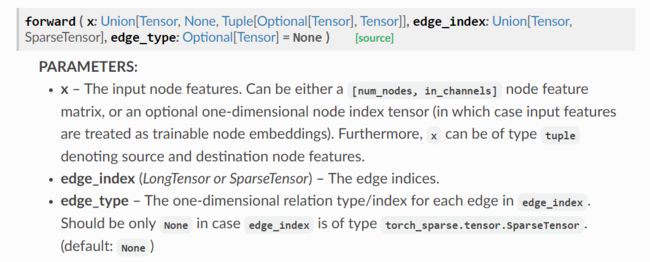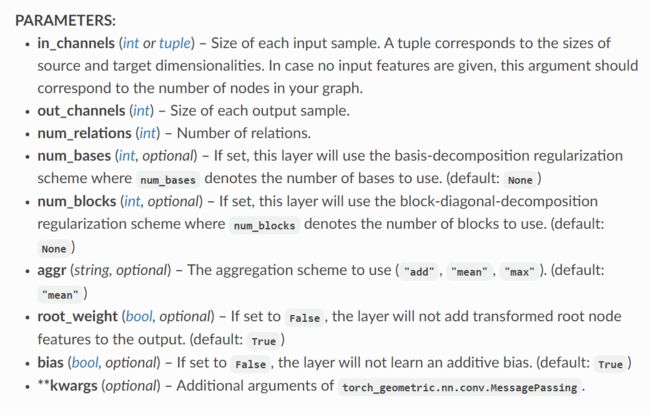PyG搭建R-GCN实现节点分类
目录
- 前言
- 数据处理
- 模型搭建
-
- 1. 前向传播
- 2. 反向传播
- 3. 训练
- 4. 测试
- 实验结果
- 完整代码
前言
R-GCN的原理请见:ESWC 2018 | R-GCN:基于图卷积网络的关系数据建模。
数据处理
导入数据:
path = osp.join(osp.dirname(osp.realpath(__file__)), '..', 'data', 'DBLP')
dataset = DBLP(path)
graph = dataset[0]
print(graph)
输出如下:
HeteroData(
author={
x=[4057, 334],
y=[4057],
train_mask=[4057],
val_mask=[4057],
test_mask=[4057]
},
paper={ x=[14328, 4231] },
term={ x=[7723, 50] },
conference={ num_nodes=20 },
(author, to, paper)={ edge_index=[2, 19645] },
(paper, to, author)={ edge_index=[2, 19645] },
(paper, to, term)={ edge_index=[2, 85810] },
(paper, to, conference)={ edge_index=[2, 14328] },
(term, to, paper)={ edge_index=[2, 85810] },
(conference, to, paper)={ edge_index=[2, 14328] }
)
可以发现,DBLP数据集中有作者(author)、论文(paper)、术语(term)以及会议(conference)四种类型的节点。DBLP中包含14328篇论文(paper), 4057位作者(author), 20个会议(conference), 7723个术语(term)。作者分为四个领域:数据库、数据挖掘、机器学习、信息检索。
任务:对author节点进行分类,一共4类。
由于conference节点没有特征,因此需要预先设置特征:
graph['conference'].x = torch.randn((graph['conference'].num_nodes, 50))
所有conference节点的特征都随机初始化。
获取一些有用的数据:
num_classes = torch.max(graph['author'].y).item() + 1
train_mask, val_mask, test_mask = graph['author'].train_mask, graph['author'].val_mask, graph['author'].test_mask
y = graph['author'].y
node_types, edge_types = graph.metadata()
num_nodes = graph['author'].x.shape[0]
num_relations = len(edge_types)
init_sizes = [graph[x].x.shape[1] for x in node_types]
homogeneous_graph = graph.to_homogeneous()
in_feats, hidden_feats = 128, 64
模型搭建
首先导入包:
from torch_geometric.nn import RGCNConv
- in_channels:输入通道,比如节点分类中表示每个节点的特征数,一般设置为-1。
- out_channels:输出通道,最后一层GCNConv的输出通道为节点类别数(节点分类)。
- num_relations:关系数。
- num_bases:如果使用基函数分解正则化,则其表示要使用的基数。
- num_blocks:如果使用块对角分解正则化,则其表示要使用的块数。
- aggr:聚合方式,默认为
mean。
于是模型搭建如下:
class RGCN(nn.Module):
def __init__(self, in_channels, hidden_channels, out_channels):
super(RGCN, self).__init__()
self.conv1 = RGCNConv(in_channels, hidden_channels,
num_relations=num_relations, num_bases=30)
self.conv2 = RGCNConv(hidden_channels, out_channels,
num_relations=num_relations, num_bases=30)
self.lins = torch.nn.ModuleList()
for i in range(len(node_types)):
lin = nn.Linear(init_sizes[i], in_channels)
self.lins.append(lin)
def trans_dimensions(self, g):
data = copy.deepcopy(g)
for node_type, lin in zip(node_types, self.lins):
data[node_type].x = lin(data[node_type].x)
return data
def forward(self, data):
data = self.trans_dimensions(data)
homogeneous_data = data.to_homogeneous()
edge_index, edge_type = homogeneous_data.edge_index, homogeneous_data.edge_type
x = self.conv1(homogeneous_data.x, edge_index, edge_type)
x = self.conv2(x, edge_index, edge_type)
x = x[:num_nodes]
x = F.softmax(x, dim=1)
return x
输出一下模型:
model = RGCN(in_feats, hidden_feats, num_classes).to(device)
RGCN(
(conv1): RGCNConv(128, 64, num_relations=6)
(conv2): RGCNConv(64, 4, num_relations=6)
(lins): ModuleList(
(0): Linear(in_features=334, out_features=128, bias=True)
(1): Linear(in_features=4231, out_features=128, bias=True)
(2): Linear(in_features=50, out_features=128, bias=True)
(3): Linear(in_features=50, out_features=128, bias=True)
)
)
1. 前向传播
查看官方文档中RGCNConv的输入输出要求:

可以发现,RGCNConv中需要输入的是节点特征x、边索引edge_index以及边类型edge_type。
我们输出初始化特征后的DBLP数据集:
HeteroData(
author={
x=[4057, 334],
y=[4057],
train_mask=[4057],
val_mask=[4057],
test_mask=[4057]
},
paper={ x=[14328, 4231] },
term={ x=[7723, 50] },
conference={
num_nodes=20,
x=[20, 50]
},
(author, to, paper)={ edge_index=[2, 19645] },
(paper, to, author)={ edge_index=[2, 19645] },
(paper, to, term)={ edge_index=[2, 85810] },
(paper, to, conference)={ edge_index=[2, 14328] },
(term, to, paper)={ edge_index=[2, 85810] },
(conference, to, paper)={ edge_index=[2, 14328] }
)
可以发现,DBLP中并没有上述要求的三个值。因此,我们首先需要将其转为同质图:
homogeneous_graph = graph.to_homogeneous()
Data(node_type=[26128], edge_index=[2, 239566], edge_type=[239566])
转为同质图后虽然有了edge_index和edge_type,但没有所有节点的特征x,这是因为在将异质图转为同质图的过程中,只有所有节点的特征维度相同时才能将所有节点的特征进行合并。因此,我们首先需要将所有节点的特征转换到同一维度(这里以128为例):
def trans_dimensions(self, g):
data = copy.deepcopy(g)
for node_type, lin in zip(node_types, self.lins):
data[node_type].x = lin(data[node_type].x)
return data
转换后的data中所有类型节点的特征维度都为128,然后再将其转为同质图:
data = self.trans_dimensions(data)
homogeneous_data = data.to_homogeneous()
Data(node_type=[26128], x=[26128, 128], edge_index=[2, 239566], edge_type=[239566])
此时,我们就可以将homogeneous_data输入到RGCNConv中:
x = self.conv1(homogeneous_data.x, edge_index, edge_type)
x = self.conv2(x, edge_index, edge_type)
输出的x包含所有节点的信息,我们只需要取前4057个,也就是author节点的特征:
x = x[:num_nodes]
x = F.softmax(x, dim=1)
2. 反向传播
在训练时,我们首先利用前向传播计算出输出:
f = model(graph)
f即为最终得到的每个节点的4个概率值,但在实际训练中,我们只需要计算出训练集的损失,所以损失函数这样写:
loss = loss_function(f[train_mask], y[train_mask])
然后计算梯度,反向更新!
3. 训练
训练时返回验证集上表现最优的模型:
def train():
model = RGCN(in_feats, hidden_feats, num_classes).to(device)
optimizer = torch.optim.Adam(model.parameters(), lr=0.01,
weight_decay=1e-4)
loss_function = torch.nn.CrossEntropyLoss().to(device)
min_epochs = 5
best_val_acc = 0
final_best_acc = 0
model.train()
for epoch in range(100):
f = model(graph)
loss = loss_function(f[train_mask], y[train_mask])
optimizer.zero_grad()
loss.backward()
optimizer.step()
# validation
val_acc, val_loss = test(model, val_mask)
test_acc, test_loss = test(model, test_mask)
if epoch + 1 > min_epochs and val_acc > best_val_acc:
best_val_acc = val_acc
final_best_acc = test_acc
print('Epoch{:3d} train_loss {:.5f} val_acc {:.3f} test_acc {:.3f}'.
format(epoch, loss.item(), val_acc, test_acc))
return final_best_acc
4. 测试
@torch.no_grad()
def test(model, mask):
model.eval()
out = model(graph)
loss_function = torch.nn.CrossEntropyLoss().to(device)
loss = loss_function(out[mask], y[mask])
_, pred = out.max(dim=1)
correct = int(pred[mask].eq(y[mask]).sum().item())
acc = correct / int(test_mask.sum())
return acc, loss.item()
实验结果
数据集采用DBLP网络,训练100轮,分类正确率为93.77%:
RGCN Accuracy: 0.9376727049431992
完整代码
代码地址:GNNs-for-Node-Classification。原创不易,下载时请给个follow和star!感谢!!
